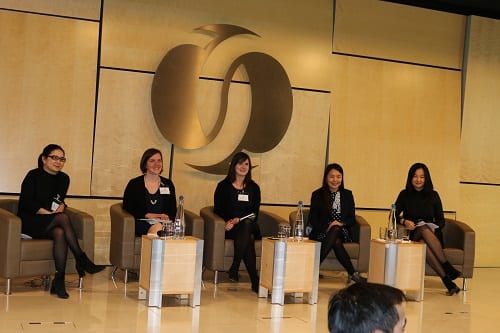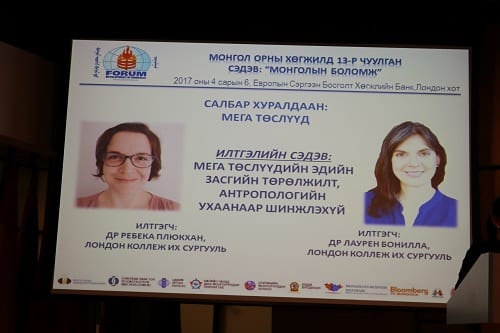Presenting on the ‘Diverse Economies of Megaprojects’ at 13th Annual Mongolia Development Forum
By Lauren Bonilla, on 24 April 2017
On Thursday, April 6, we (Rebekah Plueckhahn and Lauren Bonilla) participated in the 13th annual Mongolia Development Forum, held at the headquarters of the European Bank for Reconstruction and Development (EBRD) in London. The forum was co-organized by the Ministry of Foreign Affairs, Mongolian Embassy in the UK, Mongolian Association in the UK, Tsahim Urtuu Holboo, Mongolian Business Database, and Council of Mongolians Abroad. The theme of the day was ‘Opportunities in Mongolia’, which addressed three key topics: Business in Mongolia, Challenges and Opportunities; Social and Legal Issues; and Mega-Projects.

Bataa Tserenbat, the event organizer, introduces the mission and history of the Mongolian Development Forum to a packed auditorium.

Bayar Sanjaa, the former Prime Minister of Mongolia and current Ambassador of Mongolia to the UK, gives a welcome address.
We jointly presented in the Mega-Projects session given our respective areas of research on the effects of economic fluctuations in Ulaanbaatar (Rebekah) and the mining industry (Lauren). Although these topics are quite different from each other in many respects, we have discovered in the course of our research that our findings yield many similarities. We have observed how urban development and the large-scale mine development could both be considered mega-projects in the sense that they promise to be transformational in nature. They also involve long time horizons in their development and require large amounts of capital investment. Moreover, while much attention is given to the role of more formal institutions, stakeholders, markets, and policies in influencing the development trajectories of largescale urban and mine projects, our research has shown that a diversity of actors, processes, and practices exist within, help to shape, and are produced from a mega-project.
Lauren’s talk discussed a feature of the Tavan Tolgoi coal complex that has long been a source of debate and controversy: the multiplicity of companies that own and operate sections of the deposit located in Tsogttsetsii, Omnogobi province. In recent years there has been debate about consolidating the ownership of the Tavan Tolgoi deposit so that it is governed by one company instead of the current situation where there are three companies running mine projects in close proximity to each other: MMC/Energy Resources (a publically traded company listed on the Hong Kong stock-exchange), Erdenes Tavan Tolgoi (a state-owned company), and Tavan Tolgoi JSC (a company owned by both the local province and private shareholders). While this diversity of ownership has presented a number of governance challenges, Lauren talked about how it has also been a blessing to some degree in the current period of economic crisis. Since the mining companies are differentially exposed to coal markets and operate according to various financing streams and shareholder interests, they have pursued divergent forms of extractive activity in response to the slowdown of the coal economy. Locally, this has meant that once-booming Tsogttsetsii has avoided facing a singular bust at Tavan Tolgoi. Instead, small stores, taxi and trucking services, car repair shops, and trade activities, among other businesses, have been able to survive amid the slowdown, even though many have suffered from crushing indebtedness, bankruptcy and capital loss.
Lauren thus stressed the importance of diversification within a mega-project as a means to reduce exposure to market fluctuations, especially in a volatile industry like mining. She also drew attention to how diverse economic activities always exist around mega-projects, often in unanticipated ways. She presented an example of a scene she witnessed in April 2016 where a herding household traveled over 100 kilometers to Tsogttsetsii from another district in order to recruit temporarily unemployed mine engineers and professionals from Energy Resources to comb their large herd of goats for cashmere. In addition to benefiting the herders, the work gave the mine workers something to do instead of sitting idly at home waiting for Energy Resources to resume its operations.
Rebekah opened her presentation by encouraging the audience to think about Ulaanbaatar city as a type of ‘mega-project.’ While different to other types of mega-projects with a more singular aim, she took several key points that apply to mega-projects more generally and applied them to different aspects of Ulaanbaatar. She described this as a useful way to look at the types of transformative visions and diverse economies that the city gives rise to. The first point was how Ulaanbaatar at different planning stages, during socialism, and in the diverse postsocialist environment, has formed a political power center and a locus for economic activity. In the postsocialist environment, the Ulaanbaatar 2020 Master Plan and Development Approaches for 2030, like other plans for different mega-projects, presents visions for various types of transformations.
Rebekah went on to discuss how urban development in Ulaanbaatar is extremely sensitive to wider economic fluctuations, where the city, like other mega-projects elsewhere, is always partially completed. She emphasized how re-/development projects have long consisted of numerous diverse economic connections. This has meant that the recent economic downturn has affected vast amounts of people throughout the city. In conclusion, Rebekah discussed the economies of land access and land use that shape Ulaanbaatar, especially in the ger areas surrounding the city core. She described these diverse economies as two-fold: the economy of land access, as well as the numerous small business and livelihood opportunities that living on land can afford. She emphasized how influential these urban residents are in shaping Ulaanbaatar as a city, and the importance of incorporating these existing diverse economies in future urban development plans.
The Q&A at the end was very lively. Rebekah was asked about how traffic and air pollution can be mitigated in Ulaanbaatar, to which she emphasized the different plans and efforts currently being discussed by state agencies and development organizations in Ulaanbaatar. Lauren was asked about what Mongolia should do to quickly address the current economic crisis, to which she cautioned against anything that promises a fast fix and discussed how the Emerging Subjects project conceptualizes crisis as a space that can allow for the emergence of new possibilities.

The ‘Mega-Projects’ panel. From left to right: L. Dulamzul, Rebekah Pleuckhahn, Lauren Bonilla, B. Maral, and A. Gantuya.
Related to this latter point, audience members showed great appreciation for the all-female makeup of our panel. As one Mongolian from the Ministry of Finance mentioned during the reception, mega-projects are typically a highly masculine arena. Had the panel been organized five years ago during Mongolia’s so-called boomtime, it likely would have been formed by men in suits talking about statistics, investment opportunities, and big infrastructure projects. Instead, our panel was very much about new ways of looking at and doing things, from our talk on diverse economies to Maral Bayaraa’s presentation about the application of innovative remote sensing technologies and Gantuya Ariunsan’s analysis of strategies to interpret future coal market prices. If our panel is an example of an opening that Mongolia’s economic crisis affords, then there are indeed opportunities arising to be hopeful about.
All photos © of Ganzorig Ulaankhuu.
Acknowledgements: We thank Bataa Tserenbat for expertly organizing the event, Zula Luvsandorj for chairing our amazing all-women panel, and Ganzorig Ulaankhuu for taking photos at the event and sharing them with us.
 Close
Close












